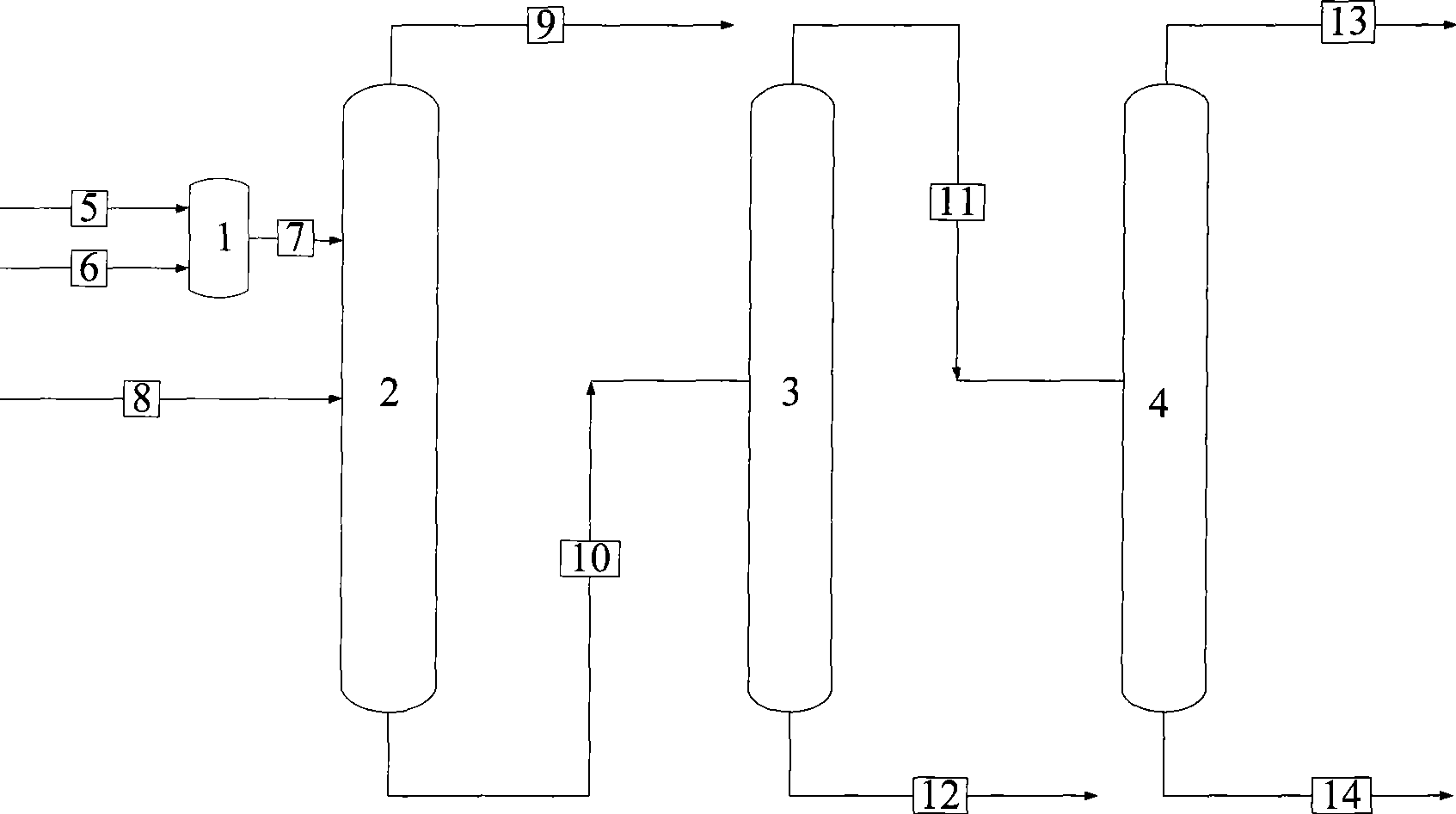Decolorization method for recycling vinyl benzene with abstraction distillation
A technology of extractive distillation and styrene, applied in the direction of distillation purification/separation, chemical transformation purification/separation, organic chemistry, etc., can solve problems such as solid waste and complex process, high equipment requirements, and complicated process
- Summary
- Abstract
- Description
- Claims
- Application Information
AI Technical Summary
Problems solved by technology
Method used
Image
Examples
Embodiment 1
[0014] After the decolorizing agent maleic acid and N-formylmorpholine are mixed and dissolved, they enter the extractive distillation tower with 30 theoretical plates, the feeding position is the 4th theoretical plate, and the amount of decolorizing agent is 1 / 2 of the raw oil feed amount. 3%, the feed position of raw oil is the 15th theoretical plate, the reflux ratio is 5, the operating pressure of the extractive distillation tower is 10KPa, the temperature at the top of the tower is controlled at 73.5~75°C, and the top of the tower obtains light oil with a lower boiling point than styrene. Components, light component chromaticity (in platinum cobalt chromaticity unit, the same below) is 50, and the tower still is styrene and solvent mixture, and this mixture enters the solvent recovery tower that the number of theoretical plates is 10, and the feeding position is the first 5 theoretical plates, the reflux ratio is 5, the operating pressure of the solvent recovery tower is 1...
Embodiment 2
[0016] After the decolorizing agent maleic anhydride and N-methylpyrrolidone are mixed and dissolved, they enter the extractive distillation tower with a theoretical plate number of 60, the feeding position is the sixth theoretical plate, and the amount of the decolorizing agent is 1% of the feed amount of the raw material oil. %, the feeding position of raw oil is the 30th theoretical plate, the reflux ratio is 1, the operating pressure of the extractive distillation tower is 12KPa, the temperature at the top of the tower is controlled at 76-78°C, and the light group with a lower boiling point than styrene is obtained at the top of the tower points, the chromaticity of light components (calculated in platinum cobalt chromaticity units, the same below) is 80, and the tower kettle is a mixture of styrene and solvent, and the mixture enters a solvent recovery tower with a theoretical plate number of 30, and the feed position is the 15 A theoretical plate, the reflux ratio is 3, t...
Embodiment 3
[0018] After the decolorizing agent acetic anhydride and sulfolane are mixed and dissolved, they enter the extractive distillation tower with 80 theoretical plates. It is the 40th theoretical plate, the reflux ratio is 0.5, the operating pressure of the extractive distillation tower is 8KPa, the temperature at the top of the tower is controlled at 66-67.5°C, the light component with a lower boiling point than styrene is obtained at the top of the tower, and the light component chromaticity (in platinum cobalt chromaticity unit, the same below) is 100, and the tower still is styrene and solvent mixture, and this mixture enters the solvent recovery tower that theoretical plate number is 50, and feed position is the 25th theoretical plate, and reflux ratio is 1. The operating pressure of the solvent recovery tower is 8KPa, and the temperature at the top of the tower is controlled at 69.5-72°C. Crude styrene with a chroma of 10 is obtained at the top of the tower. Refined styrene ...
PUM
 Login to View More
Login to View More Abstract
Description
Claims
Application Information
 Login to View More
Login to View More - R&D
- Intellectual Property
- Life Sciences
- Materials
- Tech Scout
- Unparalleled Data Quality
- Higher Quality Content
- 60% Fewer Hallucinations
Browse by: Latest US Patents, China's latest patents, Technical Efficacy Thesaurus, Application Domain, Technology Topic, Popular Technical Reports.
© 2025 PatSnap. All rights reserved.Legal|Privacy policy|Modern Slavery Act Transparency Statement|Sitemap|About US| Contact US: help@patsnap.com

